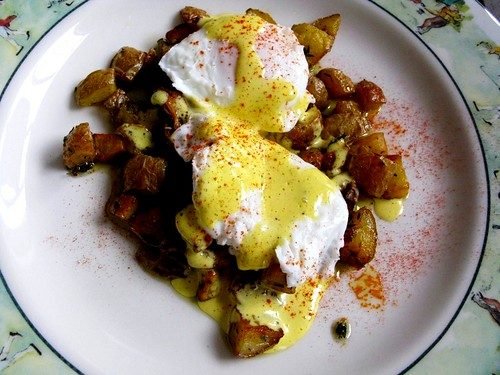Weekend Brunch: Poached Eggs on Roasted Potatoes with Hollandaise Sauce
Last weekend, I decided to make a very ambitious breakfast of poached eggs on roasted potatoes with Hollandaise sauce. It took a whole carton of eggs (three for the Hollandaise, four for poaching and the rest for throwing away after the yolks bled into the whites) but the resulting dish, as you can see, was pretty dazzling. It's the kind of breakfast that makes you, the chef, feel proud and triumphant, roaring with the might of a culinary lion. "I made that!" you keep saying to yourself, reluctant to disturb the plate with a fork. "I really made that."
"Yes," says your companion, digging in.
"I'm a culinary lion!" you continue. "Rawwwwwwwwr!!"
You may get strange looks after that, but just ignore them: you deserve your moment in the sun.
This dish involves three separate techniques that, when they come together, form a beautiful whole. Let's take them one at a time.
Technique One: Roasting The Potatoes
To roast the potatoes for this dish, I used a recipe I'd been eager to try since I read about it on Food52: Tad's Roasted Potatoes.
Tad Friend, brilliant New Yorker writer and Amanda Hesser's husband, developed a roasted potato technique that relies on one essential ingredient: old potatoes. Explains Hesser: "As potatoes age, their starch turns to sugar, making them denser, softer and easier to caramelize."
In January, I bought a bag of white potatoes for this very purpose and finally, this past weekend, I put them to use:
You preheat your oven to 375 and cut your potatoes into little cubes (3/4 inch cubes, according to the recipe, which is why you see that ruler there.) You only want to cut up enough to form an even, flat layer in your cast iron skillet.
Drop the potatoes in there and then coat generously with olive oil (a heavy pour). Season with salt and pepper and drop in 3 garlic cloves and 8 sprigs of thyme or rosemary. Toss around and flatten once again.
Place in the oven and roast for 40 minutes, scraping and turning the potatoes every ten minutes. The potatoes, when done, should be a beautiful dark brown and cooked all the way through (taste one):
That's it for the potatoes! Now on to the next technique.
Technique Two: Hollandaise (in a Blender)
The hardcore cooks among you might scoff at this shortcut for making Hollandaise sauce, but would you scoff if I told you that I learned this technique from a certain cookbook called "Mastering The Art of French Cooking" by Julia Child? I didn't think so! Yes, right there on page 81, Ms. Child has a recipe for "Hollandaise Sauce Made in the Electric Blender." It's wonderfully easy.
In the blender, place 3 egg yolks, 1/4 tsp salt, a pinch of pepper and 1 to 2 Tbs lemon juice.
Then cut up one stick of butter and melt it in a little pot until it's foaming.
Turn the blender on and carefully drip the hot, melted butter into the whirring egg yolks (you may need to use a towel so it doesn't splash up and burn you). Go slowly: drop by drop as it emulsifies and then a thin stream after that. Julia says: "By the time two thirds of the butter has gone in, the sauce will be a thick cream. Omit the milky residue at the bottom of the butter pan. Taste the sauce, and blend in more seasonings if necessary." (I added more salt, pepper and lemon juice after tasting it.)
That's it! Easy, breezy Hollandaise:
Technique Three: Poaching Eggs
No pictures here: this is an unpleasant, ugly process. And I can't claim any expertise here--it's the kind of technique you just have to do and do and do again (as illustrated in the "Julie & Julia" movie.)
Here's what I did: I filled a Dutch oven with water and carefully raised it to just under a simmer (a little bubble every now and then). I filled a separate bowl with ice water. I added salt to the hot water (just a bit) and a splash of vinegar (red wine, though white wine vinegar is preferable). I cracked each egg into a tiny bowl and carefully slipped the egg into the almost-simmering water by getting the bowl as close to the surface of the water as possible. Then, immediately, I used a spoon to coax the white around the yolk. There were lots of strands and ugly things floating around, but I ignored them.
Four minutes later, I lifted the egg with a spider into the ice water. This stops the cooking and also rinses the vinegar off the egg. I did this with the rest of the eggs (and they all, somehow, managed to stay together). Then I emptied the pot of the water and the white floaty stuff, cleaned it, refilled it with water, brought it up to a simmer and reheated the eggs.
This was certainly the most tedious part of making this breakfast but also the part I'm the most glad about. The fact that the poached eggs were solid on the outside and runny on the inside was a real culinary coup and it made the breakfast as enjoyable as it was. Here it is, again, in all its glory:
Do you dare attempt it this weekend? All you need are potatoes, garlic, thyme, a carton of eggs and a dream. The rest will take care of itself.







